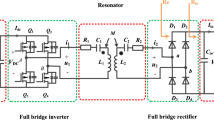Abstract
Parallel and series RLC circuits are widely encountered in numerous electrical and electronic applications. Accurate control of the voltage/current in parallel/series RLC circuits with time-varying resistance, inductance and capacitance is a challenge. In this work, an approach is proposed for control of voltage in time-varying parallel RLC circuits and of current in time-varying series RLC circuits. The proposed controller is described by an algebraic equation and forces the tracking error to quickly converge to zero. Illustrative results verify the proposed method for forcing the voltage/current in time-varying parallel/series RLC circuits to follow the targeted voltage/current trajectories efficiently. Compared with the conventional approach based on the gradient method, the proposed method demonstrates higher accuracy in controlling time-varying parallel and series RLC circuits.



Similar content being viewed by others
References
S. Bobba, I. Hajj, Maximum voltage variation in the power distribution network of VLSI circuits with RLC models, in Proceedings of the 2001 International Symposium on Low Power Electronics and Design. ACM (2001), pp. 376–381
A.N. Djanan, B.N. Nbendjo, P. Woafo, Control of vibration on a hinged-hinged beam under a non-ideal excitation using rlc circuit with variable capacitance. Nonlinear Dyn. 63(3), 477–489 (2011)
L. Hai, M. Göteman, M. Leijon, A methodology of modelling a wave power system via an equivalent RLC circuit. IEEE Trans. Sustain. Energy 7(4), 1362–1370 (2016)
A. Oksasoglu, D. Vavriv, Interaction of low-and high-frequency oscillations in a nonlinear RLC circuit. IEEE Trans. Circuits Syst. I Fundam. Theory Appl. 41(10), 669–672 (1994)
R. Ortega, D. Jeltsema, J.M. Scherpen, Power shaping: a new paradigm for stabilization of nonlinear RLC circuits. IEEE Trans. Autom. Control 48(10), 1762–1767 (2003)
G. Sampath, RLC (m) circuit models of protein structure: analysis, visualization, shape synthesis, and pattern matching, in 2006 40th Annual Conference on Information Sciences and Systems. IEEE (2006), pp. 1623–1628
S.G.S. Shiva, Correspondence between second-order linear differential equations and RLC series circuits. Proc. IEEE 51(12), 1797–1797 (1963)
L.M. Silveira, M. Kamon, I. Elfadel, J. White, A coordinate-transformed arnoldi algorithm for generating guaranteed stable reduced-order models of RLC circuits, in Proceedings of the 1996 IEEE/ACM International Conference on Computer-Aided Design. IEEE Computer Society (1997), pp. 288–294
E.I. Verriest, J.C. Willems, The behavior of linear time invariant RLC circuits, in 49th IEEE Conference on Decision and Control (CDC). IEEE (2010), pp. 7754–7758
X. Wang, I. Sakagami, Generalized dual-frequency Wilkinson power dividers with a series/parallel RLC circuit, in Microwave Symposium Digest (MTT), 2011 IEEE MTT-S International. IEEE (2011), pp. 1–1
Y. Zhang, Z. Xiao, D. Guo, M. Mao, Y. Yin, Singularity-conquering tracking control of a class of chaotic systems using zhang-gradient dynamics. IET Control Theory Appl. 9(6), 871–881 (2015)
Y. Zhang, C. Yi, Zhang Neural Networks and Neural-Dynamic Method (Nova Science Publishers, Inc., Hauppauge, 2011)
H. Zheng, B. Krauter, M. Beattie, L. Pileggi, Window-based susceptance models for large-scale RLC circuit analyses, in Proceedings 2002 Design, Automation and Test in Europe Conference and Exhibition (2002), pp. 628–633
Acknowledgements
This work is supported by the National Natural Science Foundation of China (NSFC) under Grant No. 61603078 and Fundamental Research Funds for the Central Universities at University of Electronic Science and Technology of China (UESTC) under Grant No. ZYGX2015KYQD044.
Author information
Authors and Affiliations
Corresponding author
Rights and permissions
About this article
Cite this article
Li, Z., Yin, Z. A Method for Controlling Parallel and Series RLC Circuits with Time-Varying Resistance, Inductance and Capacitance. Circuits Syst Signal Process 37, 2629–2638 (2018). https://doi.org/10.1007/s00034-017-0669-4
Received:
Revised:
Accepted:
Published:
Issue Date:
DOI: https://doi.org/10.1007/s00034-017-0669-4




